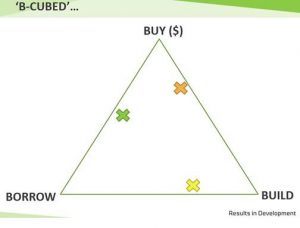
At Itad, we have been doing this for over five years, which these examples show on leadership and accountability and our story on past reflections on IWD. Recently I caught up with a selection of our pool of cross-cutting Gender Technical Leads (i.e. Gender Champions) (Marco Maragno, Ekaterina Shaleva, and Zoe Sutherland) to figure out where we are in 2021.
In doing so, we looked both outwards concerning our previous gender-focused evaluations with major international organisations, but also inwards at our gender mainstreaming track record. For instance, we’ve recently worked with UN Women on a retrospective evaluation (2011-2017) on one of their main strategic pillars, with the Global Vaccine Alliance (GAVI) reviewing their progress on gender mainstreaming (2014-2018), and likewise with the World Food Programme (WFP), evaluating their Gender Policy (2015-2020). While internally, we’ve recently revamped our Gender Equality Working Group and its associated action plans to push ourselves much further.
So, what have we learned?

What we don’t want to do in this blog is revisit previous lessons which we are already keenly aware of – such as the need to understand organisational drivers, practising what you preach and building solid accountability systems. What we want to do here is dive into some of the more granular and unique tactics or lessons.
In a nutshell, we’ve identified four activities that seem, according to our observations, to work consistently across different institutional settings. We also want to highlight two areas where traction is often more challenging concerning gender mainstreaming.
So, what works?
1. ‘Lock-in’ improvements: We’ve seen from our external engagements and internal shifts on gender mainstreaming that steady, well-resourced incremental change is key for sustained progress. This is not to say that ‘giant leaps’ don’t happen (they do – but we’ll get to that in a minute). This is not new of course – but it’s surprising how often small but critical processes and systems get lost in the mist over even short periods.
The solution: take stock every year (at least) and don’t lose easily defendable ground that has already been gained (while simultaneously prioritising from a long-list of next steps).
2. People power: Every organisation exhibits multiple drivers concerning gender mainstreaming, but it is evident that events and forums to encourage all employees to reflect on gender mainstreaming, such as ‘town halls’, ‘brown bag lunches’ or survey events, generate considerable internal and informal momentum.
When these sorts of meetings occur, there is often a groundswell of interest in gender issues – formally (during the meetings) or informally (behind closed doors and in corridors).
From our experience, these events can generate a ‘giant leap’ energy, and a conscious appreciation of how and when to harness this momentum to address ongoing challenges is a characteristic of best practice in all the evaluations that we have engaged in.
3. Benchmark to peers: We routinely employ a benchmarking process in our evaluative methodologies. The point of this is not to evaluate other organisations’ performance per se, but rather to be appreciative of what other like-minded organisations are doing in terms of gender mainstreaming. For example, in our WFP evaluation, we undertook invaluable discussions with Oxfam, UNHCR, and SIDA on each of their gender mainstream action plans.
So go ahead and reach out, compare, contrast, and learn.
4. Employ the Pareto principle1: Let’s face it, some folks don’t have the time and space to engage in the short or medium-term as they have other priorities. Organisations that appreciate a version of the Pareto principle concerning mainstreaming tend to gain more traction (20% – I don’t have time/60% – I’m kind of interested but don’t know what to do/20% – I’m in and what do I do?). In effect, we’ve seen that those organisations that implicitly understand this and do gendered political economy analysis tend to do better.
Now for the challenging bits – the unresolved and ongoing conversations:
1. The ‘i’ word: Understanding and proliferation of the ‘I’ word – Intersectionality – seems to have grown exponentially in the last five years or so. What does this mean for gender mainstreaming?
Through our Racial Inclusion and Diversity Working Group and Gender Equality Working Group we are continuing to address this issue – but readily available and published promising practice is few and far between in the sector. Others even call for language on ‘gender mainstreaming’ to be replaced with ‘equality mainstreaming’. Watch this space – we aim to contribute!
2. Beyond the ‘parity problem’?: This is a big one – how best to ensure equality of opportunity and outcome for women and men without getting caught-up in quotas (which are politically sensitive, and do not always provide the full story concerning power inequalities?) In our evaluation of the WFP gender strategy, we accidentally created a new conceptual framework – we call it ‘B-Cubed’.

This framework is a handy way to think about the approach to parity in an organisation, i.e. in what proportions do you want to buy, borrow or build male or female personnel with the aim of equality of opportunity and outcome? Thinking this through is important because a hollow commitment to 50/50 parity does not necessarily mean change, i.e. a position of power does not equate to a powerful position.
If you have any thoughts or additions about the above, we’d love to hear from you! Please get in touch (David.Walker@itad.com).

